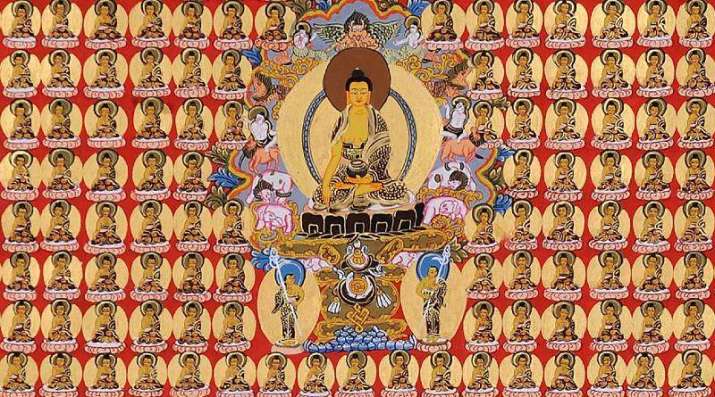FEATURES|COLUMNS|The Ordinary Buddhist
Buddhist Practice and Our Inner Light

In the Lotus Sutra, the Buddha sits atop a mountain while being attended by the fourfold sangha: monks, nuns, lay men, and lay women. He sits in silence for a long time—so long, in fact, that the attendees begin to think that something must be wrong. And then a light is emitted from the space between his eyebrows, which illuminates the heavens.
Suddenly, all of the members of the fourfold sangha were able to see and hear everything that was taking place in all of the heaven and hell realms. And what they saw and heard was buddhas and bodhisattvas practicing the Dharma in a myriad of ways.
The scene is described in the Lotus Sutra in the following passage:
In each world they teach the True Dharma; they illuminate the Buddha-Dharma and enlighten sentient beings by means of various explanations and innumerable illustrations. To those who are suffering and are cast down by old age, illness, and death they teach nirvana. (11)
In their attempts to end suffering for all sentient beings, some buddhas gave extravagant gifts, some played music, and still others used wonderful fragrances and good food to rid practitioners of defilements. The end result was an infinite number of buddhas using the most expedient means for their time and place to help others attain nirvana.
This is a beautiful story and, like the rest of the Lotus Sutra, it is rich in symbolism and metaphors that express the heart of the Buddha’s wisdom. However, the most poignant lesson is this: buddhas can be found everywhere and in everything. More than that, the purpose of Buddhist practice is to help us see the Buddha not only in ourselves but also in other sentient beings.
We see this at the beginning of the story, and in the method that the Buddha used to reveal infinite buddhas and their buddha-lands. He did not recite a magic incantation or give a long philosophical treatise on the Dharma. He sat in meditation. And it was through the power of this simple practice that the entire Buddha-body was revealed.
We may not be able to emit light from our own forehead in such a literal sense. However, the traditional Buddhist practices of bowing, chanting, sutra study, and meditation allow us to burn an inner light. First, we turn the light inward so that we can find the Buddha we carry inside us. And then we turn this spiritual light outward so that we can see the Buddha in others.
This process is known as the “actualization of enlightenment,” and Asvaghosa, an Indian Buddhist philosopher, describes it in the Awakening of Faith Sutra, where he says:
Those bodhisattvas who have completed the stages of a bodhisattva and who have fulfilled the expedient means [needed to bring forth the original enlightenment to the fullest extent] will experience the oneness [with suchness] in an instant; they will become aware of how the inceptions of [the deluded thoughts of the mind arise (jati) and will be free from the rise of any [deluded] thought. Since they are far away even from subtle [deluded] thoughts, they are able to have an insight into the original nature of Mind. (45)
The Buddhist practices of bowing, chanting, sutra study, and meditation are the expedient means that Asvaghosa is referring too. When we practice them consistently, we are able to see the inherent buddha-nature of all living things, and we see how best to end their suffering. And in times when we cannot end their suffering or they cause harm to us, we can exude compassion toward the goodness that lies within them.
 From pinterest.nz
From pinterest.nzThese are simple practices. There is nothing complicated about bowing, chanting, meditating, or studying sutras. However, that does not mean that they are easy. This is because we live in a society that encourages us to do the exact opposite of what the Buddha did on the mountain top.
We live in a society that teaches us to be suspicious, uncaring, and even cruel to our neighbors. And after a lifetime of indoctrination, it can be challenging to change our habits; to live lives of humility, kindness, and equanimity.
For this reason, we must remind ourselves that Buddhism is a marathon and not a sprint. There are years and sometime decades of negative habits built into our minds and we must be patient as we work to remove them.
However, if we are consistent in our practice; engaging in the practices of bowing, chanting, meditation, and sutra study every day, then we shift those habits, one by one. Each time we bow in front of our altars or sit on the cushion in meditation we reveal a tiny bit of our own buddha-nature to ourselves. And in the same way that removing a small amount of dirt from a window allows light to enter a room, a small amount of Buddhist practice allows our inner light to shine into the world, revealing the myriad buddhas that live around us.
References
Hakeda, Yoshito (trans.). 2005. The Awakening of Faith. Berkeley, CA: Numata Center for Buddhist Translation and Research.
Kubo, Tsugunari and Akira Yuyama (trans.). 2007. The Lotus Sutra. Berkeley, CA: Numata Center for Buddhist Translation and Research.
Related features from Buddhistdoor Global
Cleaning Our Minds and Seeing the Pure Land
“Beauty that Floats on Mud”
Shakubuku! The Advent of Nichiren Buddhism in India
Flower of Perfection: The Lotus in Buddhist Art
Poetry and poignancy that pierces the heart and mind














